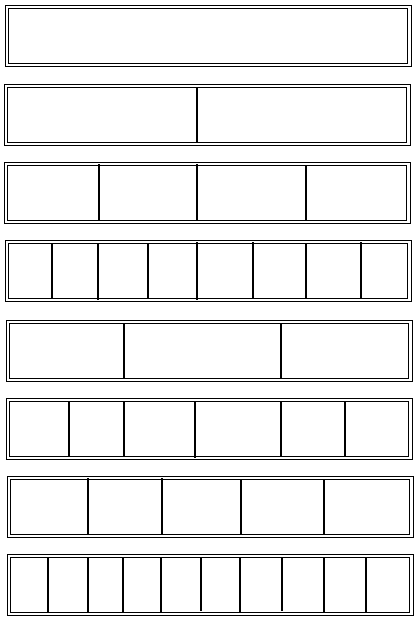 |
|
Fraction Strip Worksheet which students colored, labeled, and cut to complete this lesson |
Owner of this site does not endorse the products, services, policies, practices of, or opinions expressed by any advertisers.
Lesson Plan: Fun with Fractions
 |
|
Fraction Strip Worksheet which students colored, labeled, and cut to complete this lesson |
Unit: Fractions
Subject: Mathematics
Grade: 4th
Host Teacher/School: Mary Nelson, Bangor West Elementary School
Teacher: Amanda A. Thompson
Summary: Students will be introduced to the concept of equivalent fractions by using fraction tiles in guided and independent practice.
Prior Knowledge Needed: Student should be familiar with and comfortable in using fractions (such as 1/2, 1/4, etc.) and understand the concepts of numerator, denominator, and the standard fraction notation.
Materials:
Objectives:
Students will be able to:
- Define, Identify, describe, and visually and numerically represent equivalent fractions
Michigan Standards and Benchmarks:
IV.2.1 (elementary) - Represent whole numbers, fractions, and decimals using concrete, pictorial, and symbolic representations
IV.3.2 (elementary) – Use part-whole relationships to explore numbers, develop number concepts and understand computation
V.1.1 (elementary) – Use manipulatives to model operations with numbers
Procedure:
1. Anticipatory Set: Introduce Fraction Tiles (one set per 2-3 students) OR allow students time to color and cut their own tiles. Allow students time to “play” with tiles.
2. Direct Teaching: Explain the meaning of each tile (one whole, one half, etc.)
3. Guided Practice: Introduce equivalent factions using tiles and overhead. (Example: how many fourths tiles does it take to fill the ½ tile? 2/4=1/2, etc.) Give many examples and allow students time to practice.
4. Independent Practice: Have students make a “poster” of equivalent fractions. Have them fold their paper into eights. Instruct them to draw and color a picture of two fractions that equal each other (1/2, 1/3, ¼, 1/8, 1/12,) in each box. Students should both draw the picture and label with fraction names.
Assessment:
The teacher will assess student learning by observing students use of the fraction tiles and by checking the students’ posters. Teacher can assess students' comfort level with concept and use information to re-teach and plan future lessons.
Owner of this site does not endorse the products, services, policies, practices of, or opinions expressed by any advertisers.